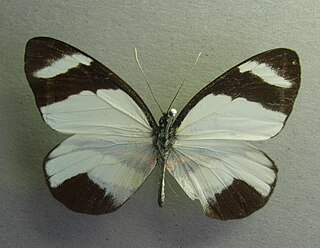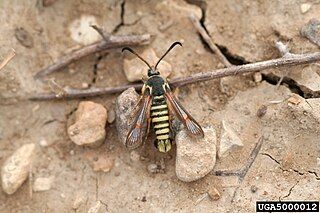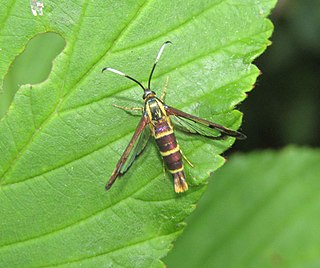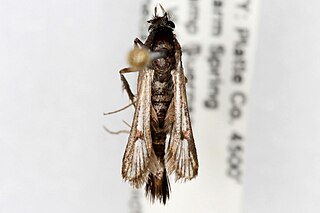
In Roman mythology, the Camenae were originally goddesses of childbirth, wells and fountains, and also prophetic deities.
Carmenta is a genus of moths in the family Sesiidae.

Perrhybris pamela, the Pamela, is a butterfly of the family Pieridae. It is found from Mexico, Honduras, El Salvador, Costa Rica and Panama, south to Colombia, Venezuela, Suriname, French Guiana, Brazil, Ecuador, Peru, and Bolivia. This species breeds in lowland rainforest at altitudes between sea level and about 900 metres.
Carmenta mimosa is a moth of the family Sesiidae. It is native to Central America, but has been introduced to the Northern Territory of Australia in 1989.

Carmenta mimuli, the coronopus borer, is a moth of the family Sesiidae. The dark form is the typical form and is found in Arizona. The whitish form is non-typical and is known from the south-western United States, from Kansas to Arizona.
Carmenta anthracipennis, the liatris borer moth, is a moth of the family Sesiidae. It was described by Jean Baptiste Boisduval in 1875, and is known from the United States, including Florida, Texas, Massachusetts and Illinois.

Carmenta bassiformis, the eupatorium borer moth, is a moth of the family Sesiidae. It was described by Francis Walker in 1856, and is found in the United States from Massachusetts to Florida, west to Wisconsin, Kansas and Texas.
Carmenta corni, the aster borer moth, is a moth of the family Sesiidae. It was described by Henry Edwards in 1881. It is known from North America, including Wisconsin.
Carmenta giliae is a moth of the family Sesiidae. It was described by Henry Edwards in 1881, and is found from western Alberta to north-western British Columbia, south to Arizona and New Mexico. The habitat consists of mid-to-high elevation montane meadows.
Carmenta ithacae is a moth of the family Sesiidae. It was described by William Beutenmüller in 1897. It is known from North America, including Florida, Arizona, Illinois, Michigan, Nebraska, New York, Virginia and Wisconsin.
Carmenta mariona is a moth of the family Sesiidae. It was described by William Beutenmüller in 1900. It is found in the United States from Montana, south to Arizona and east to Kansas.
Carmenta pallene is a moth of the family Sesiidae. It was described by Herbert Druce in 1889. It was described from Tabasco in Mexico, but it is also known from Arizona in the United States.
Carmenta phoradendri, the mistletoe borer, is a moth of the family Sesiidae. It was described by George Paul Engelhardt in 1946. It is known from south-eastern Arizona and southern Texas in the United States and from Mexico.
Carmenta prosopis is a moth of the family Sesiidae. It was described by Henry Edwards in 1882, and is known from northern Mexico, and south-western United States.
Carmenta pyralidiformis, the boneset borer, is a moth of the family Sesiidae. It was described by Francis Walker in 1856. It is known from the United States, including Arkansas, Illinois, Maryland, Massachusetts, Michigan, Missouri, New Jersey, Ohio and Virginia.
Carmenta querci is a moth of the family Sesiidae. It was described by Henry Edwards in 1882, and is known from the United States, including Colorado and Arizona.

Carmenta verecunda is a moth of the family Sesiidae. It was described by Henry Edwards in 1881, and is known from the United States, including Colorado, Utah, California and Arizona.
Carmenta haematica, the Argentine root borer, is a moth of the family Sesiidae. It was described by Ureta in 1956, and is known from Argentina and Chile.
Carmenta theobromae, the cocoa fruit borer, is a moth of the family Sesiidae. It was described by August Busck in 1910, and is known from Colombia and Venezuela.
Carmenta chromolaenae is a moth of the family Sesiidae. It is native to Venezuela, but was introduced to South Africa for the biological control of Siam weed.




